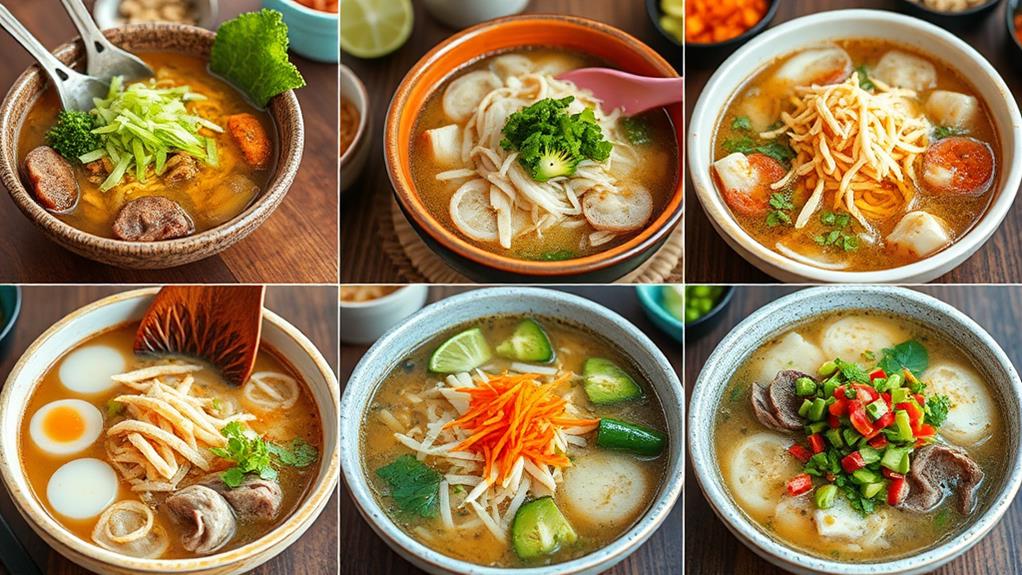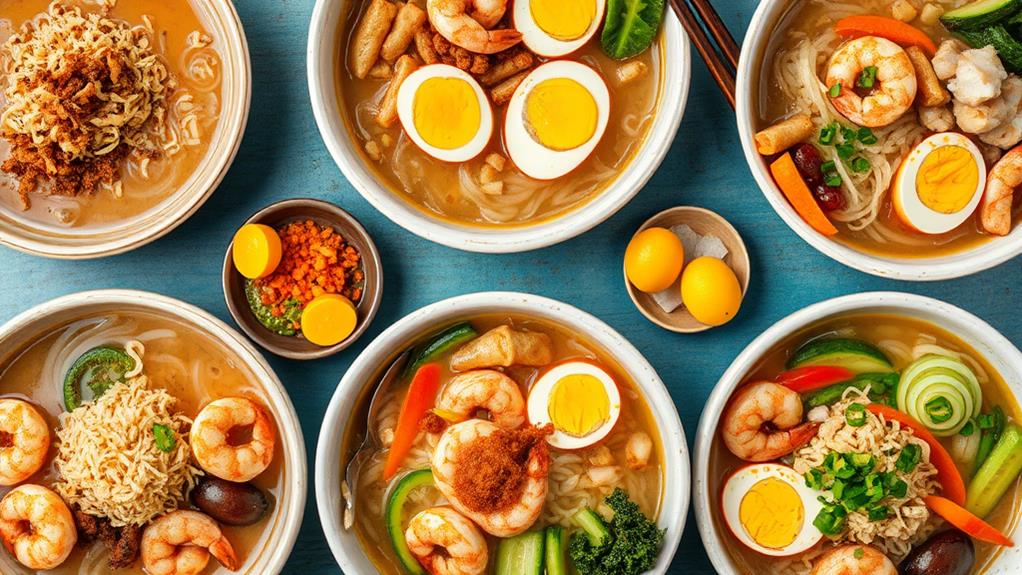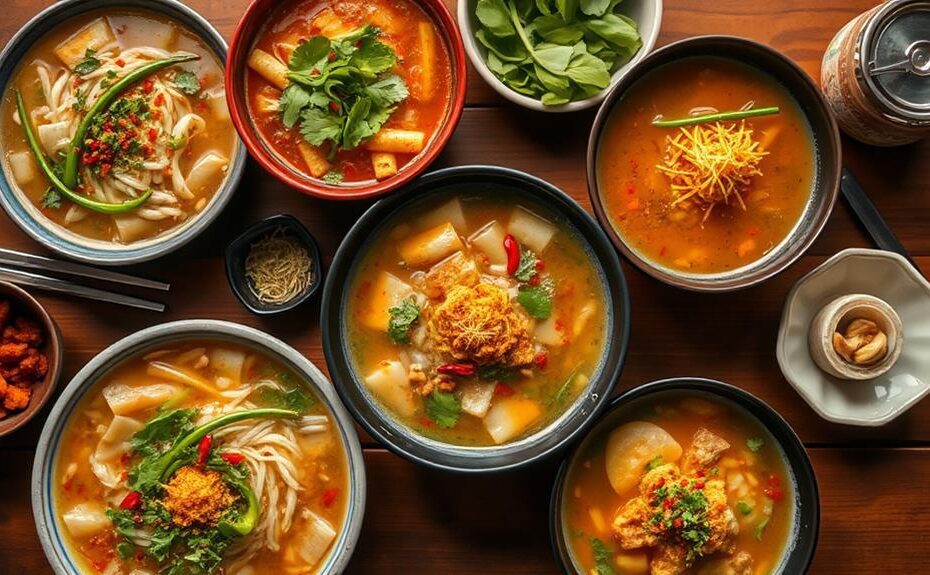Three Filipino Lomi Variations Showcase Regional Flavor Identities
Filipino lomi, a popular noodle dish, boasts diverse regional variations that reflect the country's distinct flavor profiles.
Batangas' version is characterized by a rich, meaty broth with minimal vegetables, showcasing the region's love for hearty flavors.
Cebu's variation adds a sweet and savory twist with shrimp and squid balls, highlighting the city's seafood-rich cuisine.
Bicol's spicy and creamy version incorporates chili peppers and coconut milk, demonstrating the region's bold and aromatic flavors.
Each variation presents a unique umami flavor profile, texture contrast, and protein selection, making them stand out from one another.
These differences in flavor and ingredients reflect the distinct cultural and culinary influences of each region, making Filipino lomi a fascinating dish to explore.
Exploring Lomi's Flavor Profiles

Regional Variations of Lomi
Lomi's flavor profiles vary across regions, yielding distinct and exciting results. The Batangas version is known for its thick, meaty broth and minimal vegetable inclusion, which highlights the richness of the meats used.
Umami Flavor Profile
The use of fish sauce and soy sauce in lomi contributes to its savory umami flavor, enhancing the overall taste of the dish.
Protein Variations
Different variations of lomi incorporate unique proteins such as squid balls, shrimp, or kikiam, allowing for a diverse range of flavors and textures.
Toppings and Seasonal Vegetables
Toppings like crispy pork belly and hard-boiled eggs not only add richness but also elevate the dish's flavor profile with contrasting textures.
Seasonal vegetables, when added, can introduce freshness and a slight crunch, balancing the hearty and thick nature of the lomi soup.
Culinary Heritage
In Filipino cuisine, lomi's flavor profiles are a testament to the country's rich culinary heritage.
As you explore the world of lomi, you'll discover a complex interplay of flavors that will leave you craving for more.
Regional Twists and Innovations
Regional Twists and Innovations
The Philippines' diverse regions have created their own unique variations of lomi, showcasing the country's rich culinary heritage.
Batangas Lomi: This version is known for its thick, hearty broth and generous use of meats like pork belly and liver, with minimal vegetables.
Cebu's Twist: Cebu's lomi is served with a sweeter sauce and often features shrimp and squid balls, reflecting the region's preference for a richer flavor profile.
Bicol's Spice: Bicol's variation adds a creamy texture and heat with spicy ingredients like chili peppers and coconut milk.
Ilocos and Mindanao's Flair: Ilocos incorporates local flavors like bagnet and longganisa, while Mindanao's version often includes an array of seafood, reflecting the region's coastal influence.
These regional twists and innovations are a testament to the Philippines' rich culinary heritage, highlighting the diversity and complexity of lomi, a dish deeply rooted in the country's cultural identity.
What are the Different Variations of Filipino Lomi that I Can Make at Home?
When looking to create the perfect filipino lomi recipe at home, you have a variety of options to choose from. Some popular variations include adding toppings like sliced chashu, hard-boiled eggs, or even crispy fried garlic. Experiment with different meat options such as chicken, pork, or seafood to find your favorite combination.
Creative Variations to Try

Explore Creative Variations of Lomi
As you delve into the diverse regional twists of lomi, you may find yourself inspired to experiment with new flavors and ingredients, creating your own unique variations.
Variations to Try
| Variation | Description |
|---|---|
| Seafood Lomi | Swap traditional meats for a medley of seafood, creating a lighter, ocean-inspired version of the dish. |
| Vegetarian Lomi | Replace meat with an assortment of vegetables and use vegetable broth, making it a hearty and satisfying option for plant-based diets. |
| Spicy Lomi | Add chili peppers or a dash of chili oil to the broth for a spicy kick, enhancing the dish's flavor profile. |
Additional Ideas to Elevate Your Lomi
Incorporate Korean flavors by adding kimchi and gochujang into the soup for a bold, spicy twist. Add crunchy textures by incorporating crispy fried onions or garlic along with chicharrón. These creative variations will take your lomi game to the next level, offering a range of flavors and textures to suit every palate.
Frequently Asked Questions
What to Pair With Lomi?
Choosing the Right Pairings for Lomi
When pairing with lomi, opt for condiments that complement its rich flavor profile. Traditional options like calamansi or patis add a bright, savory note.
For example, calamansi's citrus flavor cuts through the richness of lomi, while patis enhances its umami taste.
Select Side Dishes with Contrasting Textures
Pair lomi with side dishes that offer satisfying texture contrasts. Crispy lechon kawali or crunchy lumpiang shanghai are excellent choices, as they provide a nice contrast to the soft noodles.
Add Toppings for Extra Flavor and Nutrition
Hard-boiled eggs are a great topping for lomi, providing added protein and creaminess.
Other toppings like vegetables or meat can also enhance the flavor and nutritional value of the dish.
Serve with Steamed Rice for a Filling Meal
Lomi is best served with steamed rice to make it a filling meal. This classic combination is a staple in many Filipino households.
Explore Regional Variations for Unique Twists
Don't be afraid to try regional variations of lomi to experience unique twists on the classic dish.
Each region in the Philippines offers its own spin on lomi, making it a fun and exciting culinary adventure.
Are Miki and Lomi the Same?
Miki and lomi aren't the same. While they're related, lomi refers to the entire noodle soup dish, which includes a variety of ingredients and flavors.
On the other hand, miki specifically describes the thick egg noodles used in the lomi dish.
Lomi has a rich history and varied regional ingredients, which set it apart from other noodle soups.
Its popularity stems from its hearty and comforting goodness, which is rooted in its cultural significance and traditions.
When you savor lomi, you're experiencing a culinary tradition that goes beyond just the noodles.
What Is a Substitute for Lomi Noodles?
Fresh egg noodles or thick wheat noodles are great substitutes for lomi noodles due to their similar texture.
These alternatives provide a comparable chewy bite, making them ideal for dishes that traditionally use lomi noodles.
Miki noodles are another popular substitute, commonly found in Asian grocery stores.
They offer a similar texture and flavor profile to lomi noodles, making them a suitable replacement.
For those with dietary restrictions, rice noodles are a good gluten-free option.
However, it's essential to cook them carefully to avoid mushiness.
If you're looking for a low-carb alternative, vegetable noodles, such as zucchini noodles, can be a healthy and tasty substitute.
Additionally, soba, udon, or shirataki noodles can provide a unique twist on traditional lomi noodle dishes.
Remember to experiment with these substitutes to find the one that works best for your recipe.
What Is the Difference Between Lomi and Batangas?
What distinguishes Lomi from Batangas Lomi?
Lomi's origins are more general, with varying ingredients and preparation methods across regions.
In contrast, Batangas Lomi is characterized by a meatier profile, thicker broth, and unique textures from cassava flour or cornstarch. Its cooking methods prioritize protein flavors, setting it apart from other Lomi variations.
How does Batangas Lomi stand out?
While Lomi toppings and traditions differ by region,
Batangas Lomi is the most celebrated variation, renowned for its rich flavors and hearty ingredients. This has made it a staple in specialized lomi houses.
